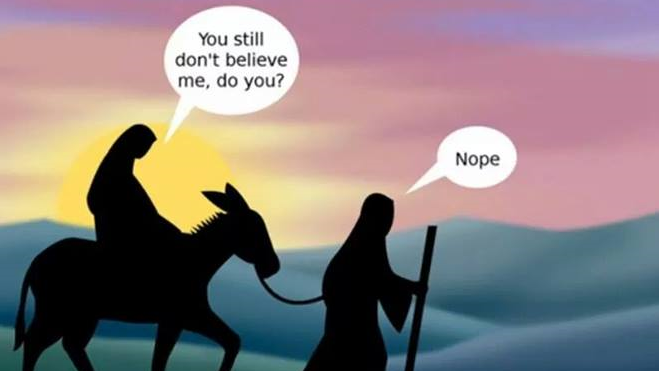With a few exceptions, today’s religions are belief systems that were formed thousands of years ago by ignorant and superstitious people during a time when there was no scientific method, no formal schooling and little critical thought. Those ancient, pre-literate people made up many elaborate stories to address the basic questions, “Where did we come from?”, “Why are we here?” and “What is that big bright thing in the sky and how did it get there?” Every culture had their own unique stories to explain them and over time these stories grew into oral traditions. These oral traditions were ultimately written down and became the basis for many of the holy books that we know today.
At that early point in our cultural development we needed explanations to make the world seem more understandable and to help us deal with those hard questions. Those answers sufficed, even if most of the answers centered on an invisible sky, tree, steam spirit, or person that used incredible unknown processes (magic or miracles) to make things happen. Mankind was still millennia away from even the most rudimentary scientific answers that the average person could understand.
A class of witch-doctors and shamans arose to take advantage of the willingness of people to believe in these fantastic, supernatural explanations. Before long, priests, oracles, and other divine interpreters found that they could gain higher social status, wealth, and political control by perpetuating and expounding upon those stories.
Since these early priests were no longer toiling in the fields, or hunting, they still had to make a living. They started to demand offerings and sacrifices, ostensibly to the gods of these stories but actually to house, feed and clothe this clerical class.
As they grew in power, they started to take actions against those who challenged their supernatural explanations, replacing them with natural ones. The clergy began to systematically silence the natural philosophers and non-believers, and as time progressed they would eventually come to kill them in pogroms, inquisitions and holy wars.
Madalyn Murray O’Hair summed it up pretty well:
“I’ll tell you what you [religionists] did with Atheists for about 1500 years. You outlawed them from the universities or any teaching careers, besmirched their reputations, banned or burned their books or their writings of any kind, drove them into exile, humiliated them, seized their properties, arrested them for blasphemy. You dehumanized them with beatings and exquisite torture, gouged out their eyes, slit their tongues, stretched, crushed, or broke their limbs, tore off their breasts if they were women, crushed their scrotums if they were men, imprisoned them, stabbed them, disemboweled them, hanged them, burnt them alive.”
These silencing techniques are still going on today. Islamic religious teachings tell Muslims that they must kill apostates. Non-believers in those countries are regularly persecuted and jailed, if not beaten and stoned to death. Mormons teach church members that normal news and information outlets are off-limits and tell families to “shun” relatives who deny the stories of Joseph Smith. Southern Baptist leaders often tell families to send their children to private-parochial schools so that they will not learn about evolution, or indeed any teachings that are contrary to their religious beliefs. Christian leaders are trying to rewrite US history in Texas in order to marginalize the anti-Christian stances held by Thomas Jefferson, Tom Paine and James Madison.
But how does it continue to be effective after all these centuries? Well, parents pass their beliefs on to their children generation after generation. Christian politicians and government leaders reinforce those beliefs as do Christian school principals, teachers, and coaches. The child is saturated at home, at church, and at school. It is against the constitutionally mandated separation of church and state for public school employees to do this but many couldn’t care less about that. They say they answer to “a higher law” and so don’t blink at breaking earthly ones.
Author Peter Boghossian calls this the tendency for one’s entire belief system to become hardened and resistant to revision due to religious and societal pressures “Doxastic Closure.” He writes:
“Combine clustering in like-minded communities with [church imposed and internet-search] filter bubbles, then put that on top of a cognitive architecture that predisposes one to belief (Shermer, 2012) and favors confirmation bias, then throw in the fact that critical thinking and reasoning require far more intellectual labor than acceptance of simple solutions and platitudes, then liberally sprinkle the virulence of certain belief systems, then infuse with the idea that holding certain beliefs and using certain processes of reasoning are moral acts, and then lay this entire mixture upon the difficulty of just trying to make a living and get through the day with any time for reflection, and voilà: Doxastic closure!”
The time has come to leave religion behind. The human species is quite capable of dealing with the world without mysticism. We can use our rational minds to find the answers that we seek. Science is doing an excellent job of digging them out of nature. Where answers are not to be had from nature itself philosophy can step in. The study of ethics and morality, after all, fall under the purview of philosophy. Morality is the system through which we determine right and wrong conduct. Ethics is the philosophical study of Morality.
Together science, i.e. naturalistic reasoning, and philosophy can carry us confidently into the future, and without recourse to supernatural beliefs. Religions only divide the human race and set us against each other. Moreover it wastes millions of man-hours and billions of dollars that otherwise could be used to improve the human condition. It is a waste that, at this juncture of human history, we can scarcely afford.

